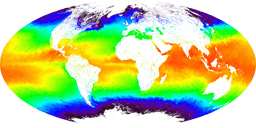Generation of Climate Data Records of Sea-Surface Temperature from Current and Future Satellite Radiometers
Welcome to the web pages of the ISSI International Study Team on the Generation of Climate Data Records of Sea-Surface Temperature from Current and Future Satellite Radiometers.
Unlike many critical parameters in the earth’s climate system the SST is a well-defined variable with a correspondence to an SI standard unit. It has been declared an Essential Climate Variable. Thus, the generation of Climate Data Records of SST is both of great importance and also tractable, at least in principle. In practice a pathway exists if the SST retrieval uncertainties are determined using accurate ship-based radiometers with calibration traceable to National Metrology Institute (NMI) standards, such those maintained by the National Physical Laboratory (NPL) in the UK and the National Institute of Standards and Technology (NIST) in the USA.
Time series of measurements intended for use in Climate Research are referred to as “Climate Data Records” (CDRs), which have been defined as “a data set designed to enable study and assessment of long-term climate change, with ‘long-term’ meaning year-to-year and decade-to-decade change. Climate research often involves the detection of small changes against a background of intense, short-term variations” (NRC 2000). It is important to continue validation efforts over the lifetimes of the spacecraft sensors to ensure that the effects of degradation of the instruments in orbit are not misinterpreted as being caused by environmental signals (NRC 2000). In generating time series of surface temperatures that span several satellite missions, the role of validation includes providing the necessary continuity in the derived fields.
The ISSI Study Project builds on a series of three infrared radiometers workshops held at the Rosenstiel School of Marine and Atmospheric Science (RSMAS), University of Miami, in collaboration with the US NIST to cross-calibrate ship-mounted, self-calibrating infrared radiometers used to validate the satellite SST. Another objective was to provide traceability of calibration to NMI SI standards. At these workshops, the radiometers were calibrated in the laboratory against black-body calibration devices that were in turn characterized by the NIST Transfer Radiometer (TXR). The measurements of the radiometers were then compared in the field, either from the RSMAS jetty, or, in the 2001 workshop, on the RSMAS research vessel. The most recent workshop was held in Miami in May 2009, in coordination with a laboratory blackbody calibration comparison held at the UK National Physical Laboratory.
This ISSI Study Project brings together scientists active in the field of satellite remote sensing of SST and ship-based radiometry from Europe, China and the USA with those from NMIs to establish the procedures for the consistent generation of CDRs of SSTs. The coordinated group activities will result in submissions to the peer-reviewed literature. This is a very timely effort given the concurrent and imminent launches of new generations of satellite radiometers on NASA, JAXA, Chinese and ESA satellites, which have the potential of extending the time series of SST fields derived from Earth Observation Satellites into future decades.
References
NRC, 2000: Issues in the Integration of Research and Operational Satellite Systems for Climate
Research: II. Implementation. National Academy of Sciences, 82 pp.


